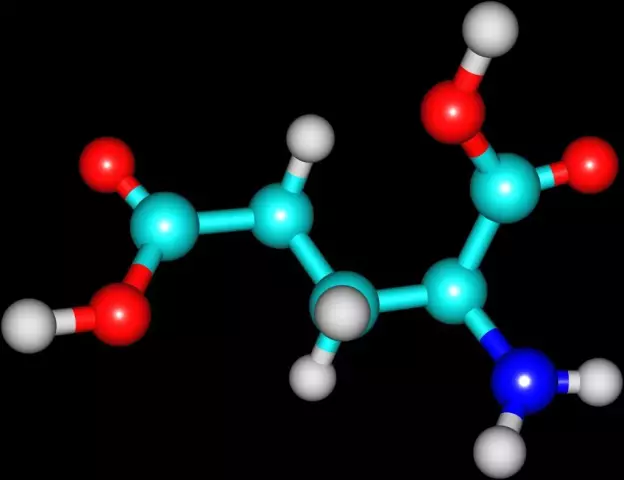- Author Rachel Wainwright [email protected].
- Public 2023-12-15 07:39.
- Last modified 2025-11-02 20:14.
Glutamic acid
Instructions for use:
- 1. Release form and composition
- 2. Indications for use
- 3. Contraindications
- 4. Method of application and dosage
- 5. Side effects
- 6. Special instructions
- 7. Drug interactions
- 8. Analogs
- 9. Terms and conditions of storage
- 10. Terms of dispensing from pharmacies
Glutamic acid is a nootropic drug for improving brain metabolism.
Release form and composition
Dosage form - tablets: round, biconvex, in a film shell of white or white with a slight shade of yellow, two layers under the shell (10 pcs. In a blister strip made of aluminum or polyvinyl chloride, 6 packs in a cardboard box; 60 pcs. In polymer cans, in a cardboard box 1 can).
The active ingredient is glutamic acid, in 1 tablet - 250 mg.
Auxiliary components: povidone, potato starch, calcium stearate monohydrate, talc.
The composition of the film shell: povidone, sucrose, colloidal silicon dioxide, titanium dioxide, beeswax, talc, liquid paraffin.
Indications for use
The use of Glutamic acid is indicated in the complex treatment of the following pathologies:
- Epilepsy, mainly in small seizures with epileptic equivalents, psychosis (intoxication, somatogenic, involutional), schizophrenia, consequences of encephalitis or meningitis, insomnia, mental exhaustion, reactive depressive states, progressive myopathy, depression;
- Down's disease, cerebral palsy, mental retardation of various origins, consequences of intracranial birth trauma, recovery and acute period of poliomyelitis;
- Toxic neuropathy with the use of isonicotinic acid hydrazides (including isoniazid).
Contraindications
- Peptic ulcer of the stomach and duodenum;
- Renal and / or hepatic impairment;
- Nephrotic syndrome;
- Oppression of bone marrow hematopoiesis;
- Anemia;
- Increased excitability, violent mental reactions;
- Obesity;
- Feverish conditions;
- Hypersensitivity to drug components.
It is prescribed with caution for liver diseases.
Method of administration and dosage
The tablets are taken orally 15-30 minutes before meals. If the patient develops symptoms of dyspepsia, it is recommended to take the drug during or immediately after a meal.
The duration of the course of treatment is prescribed by the doctor based on clinical indications, it can be from 1-2 months to 1 year.
The drug is taken 2-3 times a day, the amount of glutamic acid in one dose: adults - 1000 mg; children, depending on age:
- Up to 1 year - 100 mg;
- From 1 to 2 years - 150 mg;
- 3-4 years - 250 mg;
- 5-6 years - 400 mg;
- From 7 to 9 years old - 500-1000 mg;
- 10 years and older - 1000 mg.
In the treatment of oligophrenia, the drug is taken for several months, the dosage is prescribed at the rate of 100-200 mg per 1 kg of the child's weight.
Side effects
During the period of application of Glutamic acid, side effects may appear in the form of increased excitability, nausea, vomiting, loose stools, abdominal pain, excitation of the central nervous system, and allergic reactions.
Long-term use of the drug can lead to irritation of the oral mucosa, cracks in the lips, a decrease in hemoglobin levels, and leukopenia.
special instructions
During the period of treatment, regular general laboratory tests of urine and blood are recommended.
In case of symptoms of side effects, the dose of the drug should be reduced.
Drug interactions
Glutamic acid can be used to reverse the neurotoxic effects of other drugs.
Analogs
Glutamic acid analogues are: Armadin, Antifront, Glycine, Intellan, Instenon, Neurotropin, Cortexin, Rilutek, Cytoflavin.
Terms and conditions of storage
Store in a dry, dark place at temperatures up to 25 ° C. Keep out of the reach of children.
Shelf life is 2 years.
Terms of dispensing from pharmacies
Available without a prescription.
Information about the drug is generalized, provided for informational purposes only and does not replace the official instructions. Self-medication is hazardous to health!






